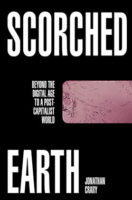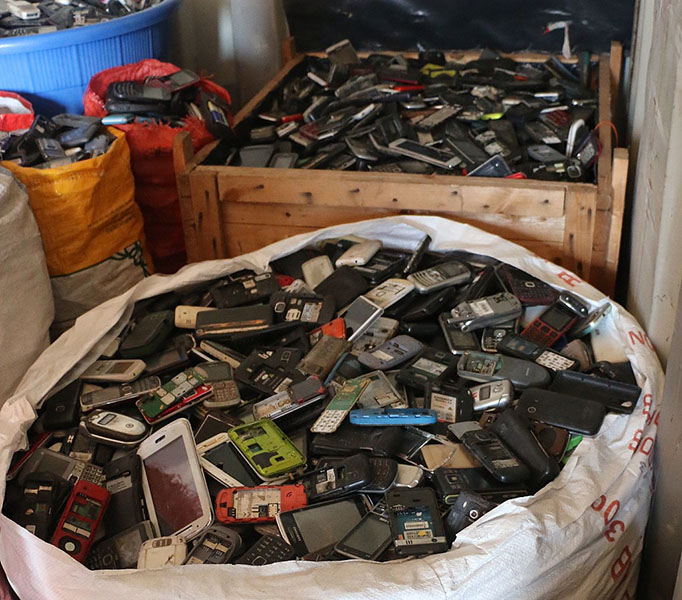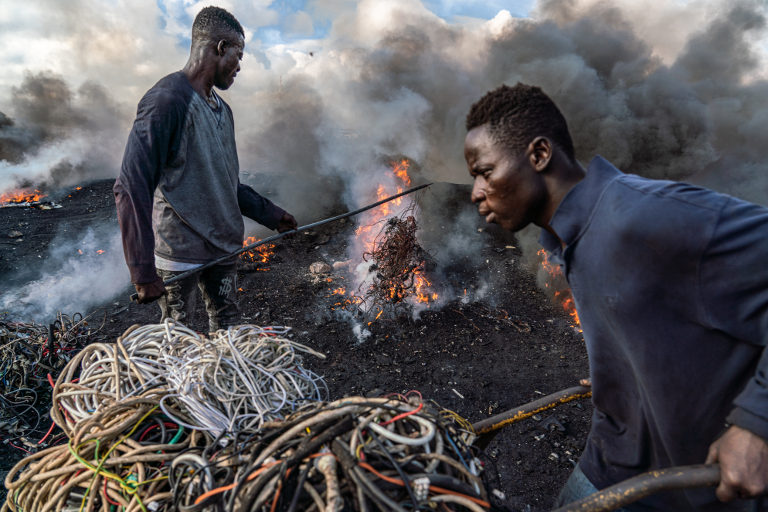The global electronics network is a sort of “bad news, good news” story in Jonathan Crary’s telling.
The bad news is that “the internet complex is the implacable engine of addiction, loneliness, false hopes, cruelty, psychosis, indebtedness, squandered life, the corrosion of memory, and social disintegration”; and that “the speed and ubiquity of digital networks maximize the incontestable priority of getting, having, coveting, resenting, envying; all of which furthers the deterioration of the world – a world operating without pause, without the possibility of renewal or recovery, choking on its heat and waste.”
The good news? The internet complex will soon collapse.

Scorched Earth, by Jonathan Crary, published by Verso, April 2022.
Crary opens his forthcoming book Scorched Earth: Beyond the Digital Age to a Post-Capitalist World with these words: “If there is to be a livable and shared future on our planet, it will be a future offline, uncoupled from the world-destroying systems and operations of 24/7 capitalism.”
If you’re looking for a careful, thorough, let’s-consider-both-sides sort of discussion, this is not the book you want. “My goal here is not to present a nuanced theoretical analysis,”Crary writes.
Rather, he wants to jar people out of the widespread faith that because we’ve grown accustomed to the internet, and because we’ve allowed it to infiltrate nearly every hour of our lives, and because it may be hard to imagine a future without the internet, therefore the internet should and will endure.
Do some good things happen on and through the Internet? Of course – but Crary is not impressed by arguments that the internet is a liberating, empowering technology for progressive movements:
“Part of the optimistic reception of the internet was the expectation that it would be an indispensable organizing tool for non-mainstream political movements … [I]t should be remembered that broad-based radical movements and far larger mass mobilizations were achieved in the 1960s and early ’70s without any fetishization of the material means used for organizing.” (Scorched Earth, p. 11)
Likewise he comments that the anti-globalization rallies of the late 1990s happened before the pandemic of smart phones, and the huge protests against the US attack on Iraq in 2003 pre-dated the onset of so-called social media. Since then, he laments, the “stupefying” effects of Internet 2.0 have dissipated people’s energies into clicktivism, leaving less time and energy for the building of personal, in-the-flesh networks that might truly challenge the direction of capitalism.
References to material pollution are scattered throughout the brief book, but Crary focuses more of his attention on the pollution of minds, emotions and perceptions. Some parts of his critique are now shared by many, both within and outside the big tech complex. He calls attention, for example, to a pervasive erosion of self-esteem:
“Each of us is demeaned by the veneration of statistics – followers, clicks, likes, hits, views, shares, dollars – that, fabricated or not, are on ongoing rebuke to one’s self-belief.” (Scorched Earth, p. 24)
Less widely understood is the immense effort put into data collection, including eye tracking, facilitated by the acquiescence of hundreds of millions of people who make their self-surveillance devices available to trackers at all times:
“We often assume that internet ‘surfing’ means the possibility of following random, uncharted visual itineraries …. From the standpoint of the bored individual, hours spent in this way may seem to be a desultory waste of time, but it is time occupied in a contemporary mode of informal work that produces value as marketable information for corporate and institutional interests. (Scorched Earth, p. 100)
The value exploited by corporate interests includes finely tuned means to convince people to buy things they don’t need, which neither they nor our ecosystems can afford.
Another section was particularly thought-provoking and sobering to me, as a nature photographer who publishes online. Crary explains that internet researchers collect reams of data on “what colors and combinations of colors and graphics are most or least eye-catching.” That information is in turn funneled back into UXD – User Experience Design – to make screen time as addictive as possible and unmediated experience of nature a fading memory:
“The ubiquity of electroluminescence has crippled our ability or even motivation to see, in any close or sustained way, the colors of physical reality. Habituation to the glare of digital displays has made our perception of color indifferent and insensitive to the delicate evanescence of living environments.” (Scorched Earth, p. 106)
Internet 2.0, in sum, turns us into willing accomplices of corporate consumerism, while undermining our self-esteem, sapping our abilities to appreciate the non-virtual world around us, and sucking up time we might otherwise devote to real community. Facebook, Twitter and their ilk have pulled off one of history’s spectacular cons – getting us to refer to their sociocidal enterprise as “social media” and getting us to believe it is “free”.

Stockpile of mobile phones for recycling/disposal, September 2017. Photo from Wikimedia Commons.
‘The Cloud is an ecological force’
In just 124 pages Crary bites off a lot – more, in fact, than he really tries to chew. From the outset, he portrays the internet complex as a final disastrous stage in global capitalism. He notes that
“the internet’s financialization is intrinsically reliant on a house-of-cards world economy already tottering and threatened further by the plural impacts of planetary warming and infrastructure collapse.” (Scorched Earth, p. 7)
But what is the physical infrastructure of the internet complex? Crary doesn’t delve into that issue. A recently published article by Steven Gonzalez Monserrate, however, makes an illuminating companion piece to Crary’s book.
Entitled “The Cloud Is Material: Environmental Impacts of Computation and Data Storage”, Monserrate’s research is available here. MIT Press has also published a shorter article adapted from the full paper. Quotes cited here are taken from the full paper.
Monserrate’s central point is that, like a cl0ud of water molecules, “the Cloud of the digital is also relentlessly material”, and further that “the Cloud is not only material, but is also an ecological force”.
Crary refers to the capitalist industrial system, of which the internet complex is now one major component, as “choking on its heat and waste”. Monserrate helps us to quantify that heat and waste.
Discussing what data center technicians refer to as a “thermal runaway event”, Monserrate writes “The molecular frictions of digital industry … proliferate as unruly heat. … Heat is the waste production of computation, and if left unchecked, it becomes a foil to the workings of digital civilization.”
In most of the data centers that keep the Cloud afloat, he adds, “cooling accounts for greater than 40 percent of electricity usage.”
Can’t the network servers and their air conditioners be switched over to renewable energy in generally cool environments? It’s not so easy, Monserrate tells us. Because of network signal latency issues, large portions of the Cloud are located as close to financial and government centers as possible. The state of Virginia’s “data center alley,” he says, was “the site of 70 percent of the world’s internet traffic in 2019”. That degree of concentrated electricity consumption is difficult if not impossible to service without huge coal, gas or nuclear generators.
The energy demands go far beyond air conditioning:
“The data center is a Russian doll of redundancies: redundant power systems like diesel generators, redundant servers ready to take over computational processes should others become unexpectedly unavailable, and so forth. In some cases, only 6–12 percent of energy consumed is devoted to active computational processes. The remainder is allocated to cooling and maintaining chains upon chains of redundant fail-safes to prevent costly downtime.” (Monserrate, “The Cloud is Material”)
Keeping your cat videos available on demand around the world, keeping Amazon’s gazillion products available for your order at 3 a.m., keeping all of Netflix’ and Hulu’s videos ready for bingeing, and keeping this entire data stream transparent to both commercial and military surveillance – well, that results in a lot of coal and gas going up as carbon dioxide emissions.
One result: “the Cloud now has a greater carbon footprint than the airline industry.”
Like the cell phones that Apple, Google and Samsung encourage you to replace every two or three years, every physical component of the internet complex has to be mined, refined, chemically transformed, assembled, packaged and shipped, before it soon becomes outmoded. Monserrate cites a Greenpeace study estimating that “less than 16 percent of the tons of e-waste generated annually is recycled.” And that recycling is often done by the lowest-paid workforces in the world, in enterprises that don’t respect the health of the workforce or the environment.
“The refuse of the digital is ecologically transformative,” Monserrate concludes.
Life without Internet
So is the Internet destined to be but one brief blip in human history? The answer seems clear to Crary – the internet will collapse along with the industrial complex that supports it:
“The internet complex, now compounded by the Internet of Things, struggles to conceal its fatal dependence on the rapidly deteriorating built world of industrial capitalism. Contrary to all the grand proposals, there never will be significant restoration or replacement of all the now broken infrastructure elements put in place during the twentieth century.” (Scorched Earth, p. 63)
Personally I am cautious about making such firm predictions, though I don’t see how the internet will persist long in its current form. Total disappearance is just one potential outcome, however. The current internet industrial complex, as Monserrate describes, includes a vast amount of redundancy, and perhaps that will make it possible to transition to a still-useful internet with only a fraction of the energy and material throughput.
In a transformed economic system, without the built-in impulsion to sell hardware and software “upgrades” to consumers on an annual basis, and without the created “need” to have every video snippet available anywhere anytime, and without the motive to maintain a vast surveillance and behavior modification apparatus – perhaps a future civilization could benefit from many of the significant benefits of the internet without paying a soul- and ecosystem-crushing price. (On this subject, see for example the research by Kris De Decker in “How to Build a Low-Tech Internet”.)
But if we don’t redirect our global economic system, and fast, the whole toxic cloud may crash whether we like it or not. And perhaps, on balance, that will be a very good thing.
“If we’re fortunate,” Crary dares to hope, “a short-lived digital age will have been overtaken by a hybrid material culture based on both old and new ways of living and subsisting cooperatively.”
Photo at top of page: A young man burning electrical wires to recover copper at Agbogbloshie, Ghana, as another metal scrap worker arrives with more wires to be burned. September 2019. Photo by Muntaka Chasant, licensed via Creative Commons, accessed through Wikimedia Commons.






